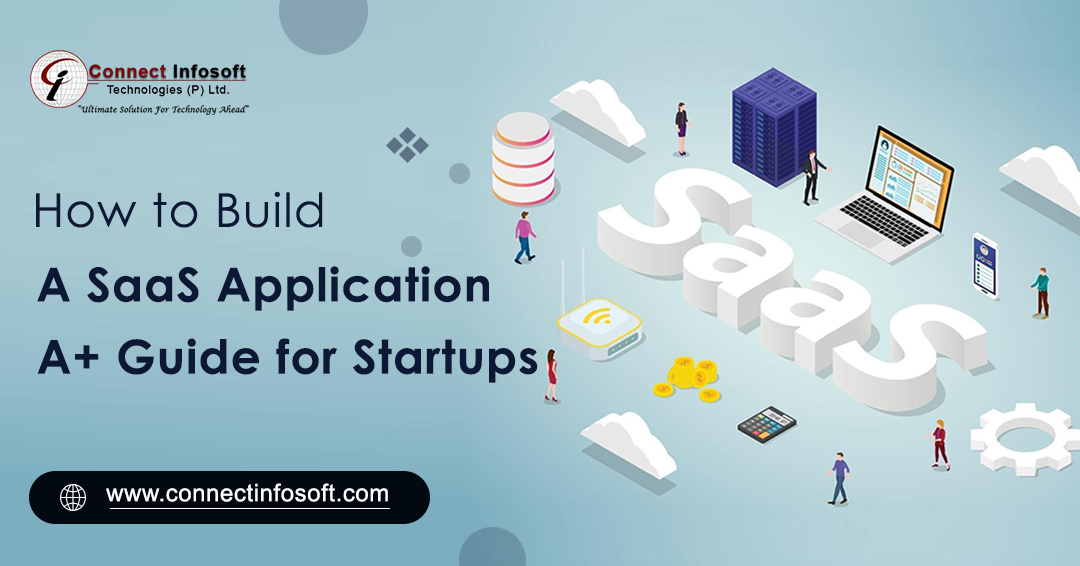How to Build a SaaS Application: A+ Guide for Startups
 Connect Infosoft
Connect Infosoft
Software-as-a-Service (SaaS) has revolutionized the way businesses operate, offering scalable and cost-effective solutions for various industries. If you're a startup looking to tap into the SaaS market, building a successful SaaS application requires careful planning, technical expertise, and a solid understanding of customer needs.
In this comprehensive guide, we will walk you through the step-by-step process of building a SaaS application, ensuring you have the knowledge and tools to launch a successful product.
10 Steps on How To Build a SaaS Application
As more businesses realize the benefits of cloud-based software solutions, the demand for SaaS applications grows. This tutorial will help you through the critical phases of creating a SaaS Application that stands out in a crowded market.
Step 1: Define Your Target Market and Unique Value Proposition
Before diving into development, identify your target market and understand their pain points. Conduct market research to gain insights into your potential customers' needs and preferences. Use this information to shape your unique value proposition, highlighting how your SaaS application solves their problems more effectively than existing solutions.
Step 2: Plan Your SaaS Application's Features and Functionality
Based on your market research, create a comprehensive list of features and functionalities your SaaS application should offer. Prioritize these features based on their importance and impact on your target audience. Consider factors such as user experience, scalability, security, and integrations with third-party tools or platforms.
Step 3: Choose the Right Technology Stack
Selecting the appropriate technology stack is crucial for building a robust and scalable SaaS application. Consider factors such as programming languages, frameworks, and databases that align with your project requirements. Popular choices for SaaS development include JavaScript frameworks like React or Angular, server-side frameworks like Node.js or Ruby on Rails, and databases like PostgreSQL or MongoDB.
Step 4: Design a User-friendly Interface
Create an intuitive and visually appealing user interface (UI) design that aligns with your target market's preferences. Focus on simplicity, ease of navigation, and clear calls-to-action. Collaborate with UI/UX designers to create wireframes and prototypes, ensuring a seamless user experience across different devices and screen sizes.
Step 5: Develop Your Minimum Viable Product (MVP)
Start by developing an MVP that includes the core features of your SaaS application. This allows you to gather user feedback and validate your concept while minimizing costs and development time. Use an agile development approach, breaking down the development process into sprints and continuously iterating based on user feedback.
Step 6: Implement Scalability and Security Measures
As you build your SaaS application, prioritize scalability and security. Implement cloud-based infrastructure and utilize scalable technologies that can handle increasing user demands. Ensure data encryption, robust authentication mechanisms, regular security audits, and compliance with data protection regulations such as GDPR or CCPA.
Step 7: Test Your SaaS Application Thoroughly
Thorough testing is essential to ensure the reliability and performance of your SaaS application. Perform functional testing to ensure that all features function as intended. Perform load testing to assess the application's performance under heavy user traffic. Additionally, conduct security testing to identify and address potential vulnerabilities.
Step 8: Deploy and Monitor Your SaaS Application
Choose a reliable hosting provider or cloud service to deploy your SaaS application. Set up monitoring tools to track performance metrics, user behavior, and potential issues. Continuously monitor and optimize your application to ensure smooth operation and an exceptional user experience.
Step 9: Provide Excellent Customer Support
Offering exceptional customer service is critical for customer satisfaction and retention. Implement a robust support system, including channels such as email, live chat, or helpdesk software. Respond promptly to user queries, provide clear documentation and tutorials, and gather feedback to improve your SaaS application continuously.
Step 10: Iterate and Improve Based on User Feedback
Listen to your users and leverage their feedback to drive continuous improvement. Release updates and new features on a regular basis based on user wants and market trends. Maintain an agile development process that allows you to adapt and enhance your SaaS application as your customer base grows.
Standard Features of a SaaS Application
A SaaS (Software-as-a-Service) application typically offers a range of standard features designed to meet the needs of its users. Here is a short description highlighting some common standard features found in SaaS applications:
1. User Authentication and Role-Based Access: SaaS applications often provide user authentication functionality, allowing users to create accounts and securely access the application. Role-based access control enables administrators to assign different levels of access and permissions to users based on their roles within the organization.
2. User Management: User management features allow administrators to manage user accounts, including creating and deleting users, resetting passwords, and updating user information. This feature ensures efficient user administration and helps maintain the security of the application.
3. Dashboard and Analytics: SaaS applications usually provide a user-friendly dashboard that offers an overview of key metrics and data relevant to the application's purpose. Analytics features enable users to track and analyze data, generate reports, and gain insights into their operations or performance.
4. Data Storage and Management: SaaS applications often include data storage capabilities, allowing users to store and manage their data securely in the cloud. This feature ensures data accessibility, reliability, and scalability, relieving users of the need to maintain their own infrastructure.
5. Collaboration and Communication Tools: Many SaaS applications facilitate collaboration and communication among users. Features such as real-time messaging, document sharing, task management, and shared calendars enable teams to work together effectively, fostering productivity and efficiency.
6. Integration with Third-Party Services: SaaS applications often offer integrations with popular third-party services and platforms, allowing users to leverage existing tools seamlessly. Integrations may include payment gateways, email marketing services, customer relationship management (CRM) systems, or project management tools.
7. Notifications and Alerts: SaaS applications often include notification and alert systems to keep users informed about important events, updates, or actions within the application. Notifications can be sent via email, in-app messages, or push notifications, ensuring users stay up to date with relevant information.
The Advantages of Using SaaS Applications in Your Business
Leveraging Software as a Service (SaaS) applications offers numerous benefits for businesses. SaaS refers to cloud-based software solutions that are accessible via the internet. Here are the key advantages of utilizing SaaS applications for your business:
Cost Savings: SaaS eliminates the need for upfront hardware investments and software licenses. Instead, businesses can pay a subscription fee based on their usage, making it a cost-effective solution. Companies can redirect their resources to other critical areas of their operations.
Scalability and Flexibility: SaaS applications offer scalability, allowing businesses to easily adjust their usage and features as their needs evolve. Whether you need to add or reduce the number of users or increase storage capacity, SaaS applications can accommodate your changing requirements.
Easy Implementation: SaaS applications are typically ready to use, eliminating the need for complex installations and configurations. Users can access the software immediately after subscribing, saving time and reducing IT-related hassles.
Accessibility and Collaboration: SaaS applications can be accessed from anywhere with an internet connection, enabling remote work and collaboration. Teams can interact in real time, share documents, and communicate in real time, boosting productivity and efficiency.
Automatic Updates and Maintenance: SaaS providers handle software updates, patches, and maintenance tasks, relieving businesses of the burden of managing these processes. Users can benefit from the latest features and security enhancements without any additional effort.
Enhanced Security: SaaS providers prioritize security and invest in robust measures to protect their platforms and users' data. They employ encryption, regular backups, and advanced security protocols to ensure data confidentiality and integrity.
Conclusion:
Building a successful SaaS application requires careful planning, technical expertise, and a customer-centric approach. By following this step-by-step guide, you can navigate the complex process of developing a SaaS application for your startup. Remember to prioritize user needs, focus on scalability and security, test rigorously, and provide excellent customer support. With perseverance and continuous iteration, your SaaS application has the potential to thrive in the competitive market and drive your startup's success.
Tags: How to Build a SaaS Application, SaaS Application Startups Guide, SaaS Application Development, SaaS Application Development Service in India, SaaS Application Development Company, Benefits SaaS Applications, SaaS Application Development Team, Looking for SaaS App Designers, Looking for Saas App service in USA
Subscribe to my newsletter
Read articles from Connect Infosoft directly inside your inbox. Subscribe to the newsletter, and don't miss out.
Written by

Connect Infosoft
Connect Infosoft
Connect Infosoft Technologies Pvt. Ltd. provides Website design and Mobile App development services to global clients. Connect Infosoft has more than 25 years of experience in software development with a strong focus on mobile app development for all kinds of platforms including iOS and Android. We were established in 1999, and have been serving our customers everywhere throughout the world. Connect Infosoft's Head Office is based in New Delhi, India, and has Branch Office in Orissa. It also has a portrayal in the United States. In business for more than 25 years, we are constantly prepared for confronting any kind of challenge. Major Service Offerings: -Web Application Development -ETL Services -SaaS & MVP Development -Mobile App Development -Data Science & Analytics -Artificial Intelligence -Digital Marketing -Search Engine Optimization -Pay-Per-Click advertising campaigns -Blockchain -DevOps -Amazon Web Services -Product Engineering -UI/UX Founder of Connect Infosoft Mr. Sanjay Sahoo with his astounding and clear vision has achieved numerous accolades around the world for his excellence in the field of IT. We can make world-class ventures, which upgrade the organization brand image colossally. We work in close coordination in light of the customers, bearing in mind doing outstanding and quality work. Expert Developer Award from Digital Dujour and Best Developer from Pepsico, NY, US honors are confirmation of this truth. Kindly message me for an in-depth conversation. Book a Free 30-minute consultation with our experts: https://calendly.com/connectinfosoft Contact Number: +1 323-522-5635 Email: info@connectinfosoft.com Visit us: https://www.connectinfosoft.com/ Send us your Queries: https://www.connectinfosoft.com/lets-work-together/